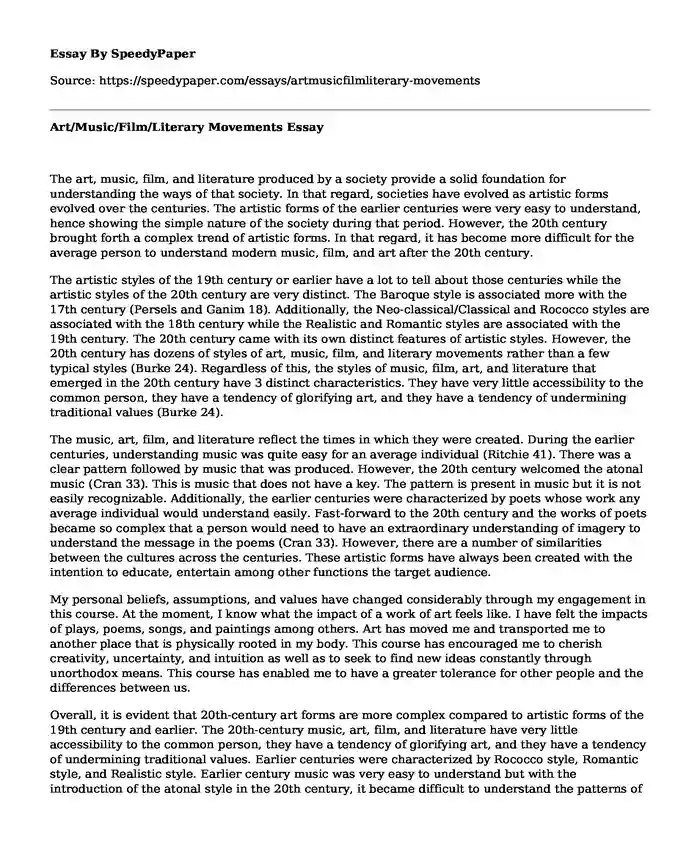
| Type of paper: | Essay |
| Categories: | Education Human resources Analysis |
| Pages: | 3 |
| Wordcount: | 691 words |
The art, music, film, and literature produced by a society provide a solid foundation for understanding the ways of that society. In that regard, societies have evolved as artistic forms evolved over the centuries. The artistic forms of the earlier centuries were very easy to understand, hence showing the simple nature of the society during that period. However, the 20th century brought forth a complex trend of artistic forms. In that regard, it has become more difficult for the average person to understand modern music, film, and art after the 20th century.
The artistic styles of the 19th century or earlier have a lot to tell about those centuries while the artistic styles of the 20th century are very distinct. The Baroque style is associated more with the 17th century (Persels and Ganim 18). Additionally, the Neo-classical/Classical and Rococco styles are associated with the 18th century while the Realistic and Romantic styles are associated with the 19th century. The 20th century came with its own distinct features of artistic styles. However, the 20th century has dozens of styles of art, music, film, and literary movements rather than a few typical styles (Burke 24). Regardless of this, the styles of music, film, art, and literature that emerged in the 20th century have 3 distinct characteristics. They have very little accessibility to the common person, they have a tendency of glorifying art, and they have a tendency of undermining traditional values (Burke 24).
The music, art, film, and literature reflect the times in which they were created. During the earlier centuries, understanding music was quite easy for an average individual (Ritchie 41). There was a clear pattern followed by music that was produced. However, the 20th century welcomed the atonal music (Cran 33). This is music that does not have a key. The pattern is present in music but it is not easily recognizable. Additionally, the earlier centuries were characterized by poets whose work any average individual would understand easily. Fast-forward to the 20th century and the works of poets became so complex that a person would need to have an extraordinary understanding of imagery to understand the message in the poems (Cran 33). However, there are a number of similarities between the cultures across the centuries. These artistic forms have always been created with the intention to educate, entertain among other functions the target audience.
My personal beliefs, assumptions, and values have changed considerably through my engagement in this course. At the moment, I know what the impact of a work of art feels like. I have felt the impacts of plays, poems, songs, and paintings among others. Art has moved me and transported me to another place that is physically rooted in my body. This course has encouraged me to cherish creativity, uncertainty, and intuition as well as to seek to find new ideas constantly through unorthodox means. This course has enabled me to have a greater tolerance for other people and the differences between us.
Overall, it is evident that 20th-century art forms are more complex compared to artistic forms of the 19th century and earlier. The 20th-century music, art, film, and literature have very little accessibility to the common person, they have a tendency of glorifying art, and they have a tendency of undermining traditional values. Earlier centuries were characterized by Rococco style, Romantic style, and Realistic style. Earlier century music was very easy to understand but with the introduction of the atonal style in the 20th century, it became difficult to understand the patterns of music. The knowledge I have acquired from this course is important because it has enabled me to have greater tolerance towards people who are different from me. Finally, I believe music, art, and the film will continue to evolve as they have evolved in the past centuries.
Works Cited
Burke, Peter. Popular culture in early modern Europe. Routledge, 2017.Cran, Rona. Collage in Twentieth-Century Art, Literature, and Culture: Joseph Cornell, William Burroughs, Frank O'Hara, and Bob Dylan. Routledge, 2016.Persels, Jeff, and Russell Ganim. Fecal Matters in Early Modern Literature and Art: Studies in Scatology. Routledge, 2017.Ritchie, Leslie. Women writing music in late eighteenth-century England: social harmony in literature and performance. Routledge, 2017.
Cite this page
Art/Music/Film/Literary Movements. (2022, Jul 18). Retrieved from https://speedypaper.com/essays/artmusicfilmliterary-movements
Request Removal
If you are the original author of this essay and no longer wish to have it published on the SpeedyPaper website, please click below to request its removal:
- Failure Essay Samples
- Education Essay Sample - Ph.D. Admission Request
- Introduction to Pregnancy, Free Essay Sample
- Free Essay with the Article Summary on a Government Issue
- Free Essay Describing Social Change Project
- Free Essay - Factors Affecting Internet Use in American Population
- Essay Sample on Anxiety Due to Coronavirus Pandemic
Popular categories




